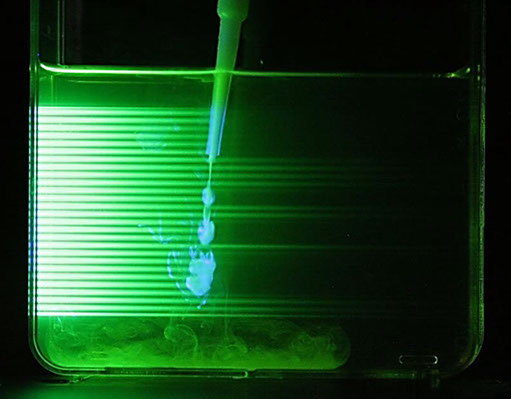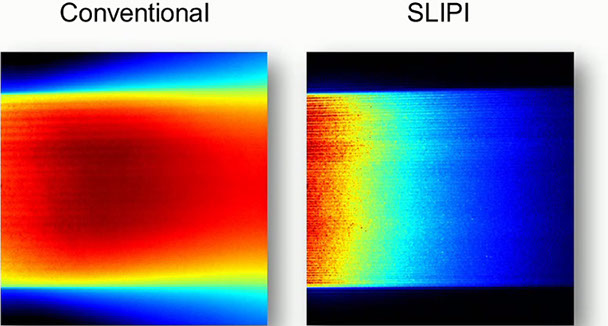

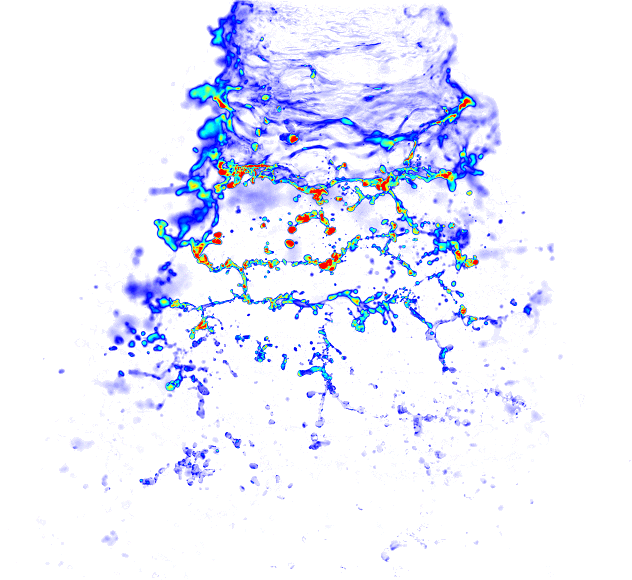

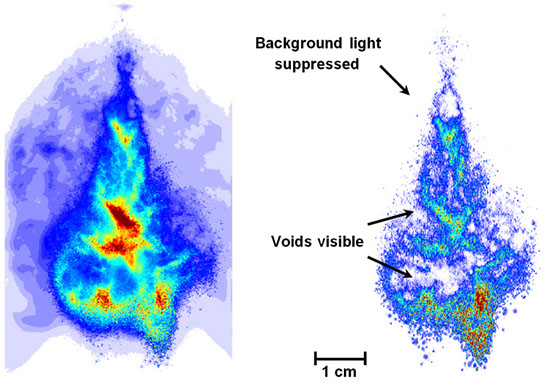




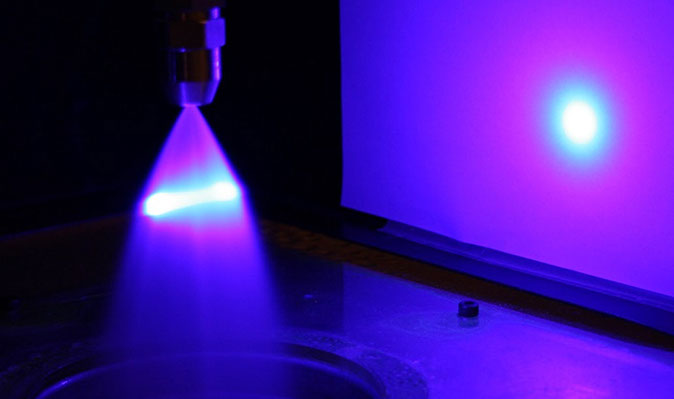
Imaging respiratory droplets
Understanding disease spreading through high-speed imaging (4000 images per second) of respiratory droplets. A person saying the letter "P" that creates a large number of droplets. These droplets evaporate and some will become aerosols that are suspended in the air for a long time and can contribute to disease spreading.
Imaging spray
breakups
Understanding spray formation:
- Observing the presence of a liquid core or liquid sheet
- Observing liquid ligaments created from primary breakups
- Observing the small droplets created from secondary breakups
Such experimental data serves at validating modern CFD spray models, which is of utmost importance for reliable predictions of spray behaviors.
Imaging spray
breakups
Understanding spray formation:
- Observing the presence of a liquid core or liquid sheet
- Observing liquid ligaments created from primary breakups
- Observing the small droplets created from secondary breakups
Such experimental data serves at validating modern CFD spray models, which is of utmost importance for reliable predictions of spray behaviors.
Transient
fuel sprays
Diesel and GDI sprays are two wide examples of transient fuel sprays which are commonly used in internal combustion engines (e.g cars and trucks).
Being able to accurately obtain the size, the velocity and the temperature of the droplet field requires the use of novel imaging techniques.
Transient
fuel sprays
Diesel and GDI sprays are two wide examples of transient fuel sprays which are commonly used in internal combustion engines (e.g cars and trucks).
Being able to accurately obtain the size, the velocity and the temperature of the droplet field requires the use of novel imaging techniques.
Microscopic
imaging
We develop and apply microscopic imaging approaches primarily for the characterization of spray dynamics near the nozzle region.
Those approaches aim at capturing the dynamics of the spray at high image resolution. Those techniques allow visualizing droplet formation induced by primary and secondary breakup processes.
Microscopic
imaging
We develop and apply microscopic imaging approaches primarily for the characterization of spray dynamics near the nozzle region.
Those approaches aim at capturing the dynamics of the spray at high image resolution. Those techniques allow visualizing droplet formation induced by primary and secondary breakup processes.
Multiple light
scattering
When light propagates through a spray, photons interact multiple times with the surrounding droplets. This phenomenon known as multiple scattering induces unwanted effects such as blurs on the recorded image and errors on spray measurements.
One way of understanding those effects is to simulate the problem using Monte Carlo Simulation
Multiple light
scattering
When light propagates through a spray, photons interact multiple times with the surrounding droplets. This phenomenon known as multiple scattering induces unwanted effects such as blurs on the recorded image and errors on spray measurements.
One way of understanding those effects is to simulate the problem using Monte Carlo Simulation
1 - 9
<
>

The Spray & Imaging group belongs to the Division of Combustion Physics, at the Department of Physics in Lund University, Sweden.
The group was created in 2015 thanks to the funding of European Research Council through the ERC Starting Grant project "Spray-Imaging".
Structured Laser Illumination Planar Imaging (SLIPI)
SLIPI is an imaging technique created in the Spray-Imaging group that employs a special type of illumination, based on lines pattern. By taking advantage of this "line" structure, one can significantly improve the visibility through scattering media such as in optically dense sprays. The technique can also be used to any planar imaging measurements where a surrounding background light must be suppressed.
Structured Laser Illumination Planar Imaging (SLIPI)
SLIPI is an imaging technique created in the Spray-Imaging group that employs a special type of illumination, based on lines pattern. By taking advantage of this "line" structure, one can significantly improve the visibility through scattering media such as in optically dense sprays. The technique can also be used to any planar imaging measurements where a surrounding background light must be suppressed.
Structured Laser Illumination Planar Imaging (SLIPI)
SLIPI is an imaging technique created in the Spray-Imaging group that employs a special type of illumination, based on lines pattern. By taking advantage of this "line" structure, one can significantly improve the visibility through scattering media such as in optically dense sprays. The technique can also be used to any planar imaging measurements where a surrounding background light must be suppressed.
Frequency Recognition
Algorithm for Multiple
Exposure (FRAME)
FRAME is an imaging technique created in the Spray-Imaging group that employs a multiplexed line pattern illumination.
The multiplexed patterns allows FRAME to acquire several images in a single exposure. This can be used to acquire several images in an extremely rapid succession, capture 3D data or instantaneous multispectral imaging.
Frequency Recognition
Algorithm for Multiple
Exposure (FRAME)
FRAME is an imaging technique created in the Spray-Imaging group that employs a multiplexed line pattern illumination.
The multiplexed patterns allows FRAME to acquire several images in a single exposure. This can be used to acquire several images in an extremely rapid succession, capture 3D data or instantaneous multispectral imaging.
Frequency Recognition
Algorithm for Multiple
Exposure (FRAME)
FRAME is an imaging technique created in the Spray-Imaging group that employs a multiplexed line pattern illumination.
The multiplexed patterns allows FRAME to acquire several images in a single exposure. This can be used to acquire several images in an extremely rapid succession, capture 3D data or instantaneous multispectral imaging.
Frequency Recognition
Algorithm for Multiple
Exposure (FRAME)
FRAME is an imaging technique created in the Spray-Imaging group that employs a multiplexed line pattern illumination.
The multiplexed patterns allows FRAME to acquire several images in a single exposure. This can be used to acquire several images in an extremely rapid succession, capture 3D data or instantaneous multispectral imaging.
Imaging solutions
in spectroscopy
Spectroscopic measurements suffer from an interference known as stray light, which potentially may conceal spectral structures.
We have developed a technique to address this issue, called Periodic Shadowing. The method is based on placing a transmission grating at the entrance of the slit, which effectively modulates all spectral lines along the spatial direction.
Imaging solutions
in spectroscopy
Spectroscopic measurements suffer from an interference known as stray light, which potentially may conceal spectral structures.
We have developed a technique to address this issue, called Periodic Shadowing. The method is based on placing a transmission grating at the entrance of the slit, which effectively modulates all spectral lines along the spatial direction.
4 - 9
<
>
Spray Diagnostics
Advanced Imaging
